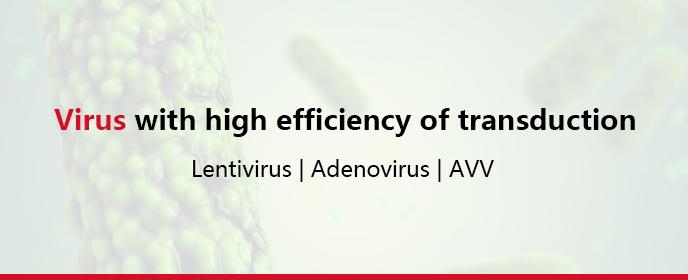The lentivirus vector is based on HIV-1 (Human Immunodeficiency Virus-1) and developed from herpes virus VSVG capsid. It is a pseudovirus, as its pathogenic genes will be deleted and replaced by exogenous target genes. Lentiviruses have a wide spectrum of infections and can effectively infect divisive and non-divisive cells. Exogenous genes can be effectively integrated into host chromosomes by Lentiviruses, to achieve continuous expression. Thus, lentivirus has become a useful tool for introducing exogenous genes. Lentiviral systems have been widely used in various cell lines for gene knockin/knockout, overexpression, RNA interference, microRNA related researches and in vivo experiments.
Product Specs
| Standard | Titer | Turnaround | Application |
|---|
| Standard | 1*10^8 TU | 2-3weeks | Cell transduction |
| Large size | 1*10^9 TU | 2-3weeks | Cell transduction |
| Ultra-purified | 1*10^9 TU | 2-3weeks | In vivo injection |
Work Flow and Validation:
FAQ about lentivirus, click to show 
·FAQ about lentivirus:
1. How long does it take for gene expression after transduction?
It takes a long time for expression after lentivirus transduction. But fluorescence can be observed 24 hours after transduction on the cells with strong metabolism (such as 293T, HEK293, etc.); the fluorescent protein expression of cells with slow metabolism (such as primary culture cells, neural stem cells, embryonic stem cells, etc.) takes a longer time, i.e. 72-96 hours or even longer after transduction. The transduced cells can be continuously cultured for one week, and the effect of transduction of the virus to the target cells can be determined by observing the expression time and intensity of fluorescence.
2. How to improve transduction efficiency?
Ensure that the cells are in good growth condition before transduction. Use 293T for titer test to verify whether the titer of virus drops significantly; properly increase the MOI and extend the transduction time.
3. After lentivirus transduction, the condition of cells is very poor or even a large number of deaths. How to solve this problem?
Poor cell conditions before transduction, exceeding MOI, and cytotoxicity of target genes may lead to abnormal cell conditions.The main solutions are:
(1) make sure the pre-transduction cell condition;
(2)reduce the MOI to verify the cytotoxicity of the target gene;
(3) observe the cells after 6 hours of transduction, change the fresh medium in case of abnormality of cells, if not, change the medium 24 hours later.
The lentivirus knockout plasmids would be packaged as lentiviruses.After the cells are infected with lentiviruses, it can stably express gRNA and Cas9 protein to knockout the target gene.
Knockout lentivirus vector selection:
| YKO series | Vector | Reporter gene; Selection marker |
|---|
| Lentiviral YKO plasmid | YKO-LV001-single-gRNA | EGFP/mCherry,Puro/Neo |
| YKO-LV001-dual-gRNA | EGFP/mCherry,Puro/Neo |
| Lentiviral Cas9 plasmid | YCas-LV001 | EGFP |
| YCas-LV002 | Hygro |
Because of the limitation of lentivirus capacity, the Cas9 protein, which is ~4kb, should be packed separately from gRNA. Generally, the two lentiviruses are used to co-infect the host cells.
The gene expression plasmid would be constructed and packaged as lentivirus. After infecting host cells with overexpression lentivirus, drug resistance carried by virus vector can be used for drug screening, so as to obtain stable cell lines expressing target genes. Lentivirus can be used in vitro (including cell lines, immortalized cells, primary cells, and stem cells) and in vivo.
Gene overexpression lentivirus vector selection:
| YOE series | Vector | Reporter gene; Selection marker |
|---|
| Lentiviral YOE plasmid | YOE-LV001 | EGFP/Puro |
| YOE-LV002 | mCherry/Puro |
| YOE-LV003 | EGFP/Neo |
| YOE-LV004 | mCherry/Neo |
| YOE-LV005 | Puro |
| YOE-LV006 | EGFP |
| YOE-LV007 | mCherry |
| YOE-LV008 | Luciferase/Puro |
The shRNA expression vector would be constructed and packaged as lentivirus. After infecting host cells with lentivirus, drug resistance carried by virus vector can be used for drug screening, so as to obtain stable cell lines expressing shRNA. Lentivirus can be used in vitro (including cell lines, immortalized cells, primary cells, and stem cells) and in vivo.
Gene interference lentivirus vector selection :
| YSH series | Vector | Reporter gene; Selection marker |
|---|
| Lentiviral YSH plasmid | YSH-LV001-shRNA | EGFP/Puro |
| YSH-LV002-shRNA | mCherry/Puro |
| YSH-LV003-shRNA | EGFP/Neo |
| YSH-LV005-shRNA | EGFP/Hygro |
| YSH-LV004-shRNA | mCherry/Neo |
| YSH-LV006-shRNA | Puro |
| YSH-LV007-shRNA | EGFP |
| YSH-LV008-shRNA | mCherry |
| YSH-LV009-shRNA | Luciferase/Puro |







